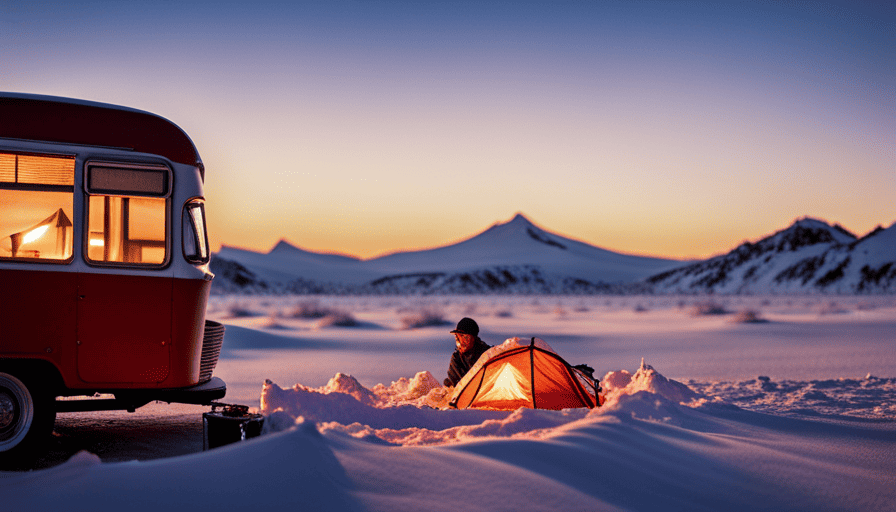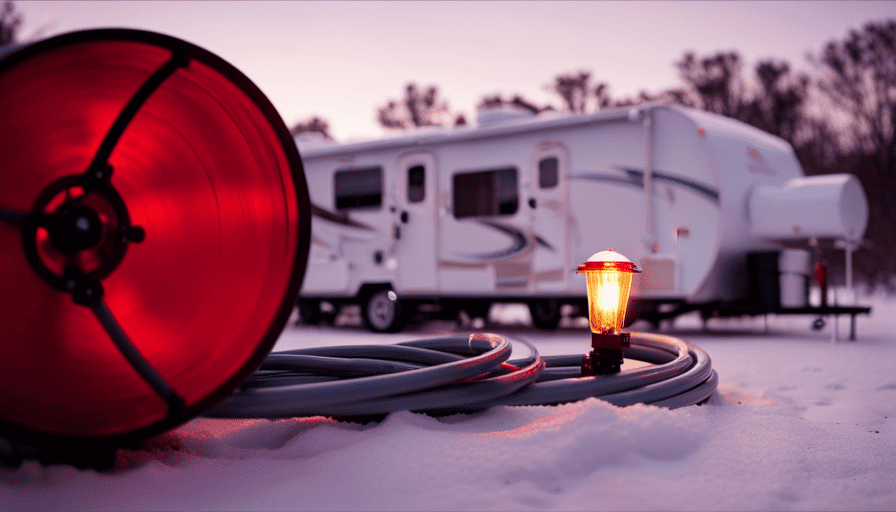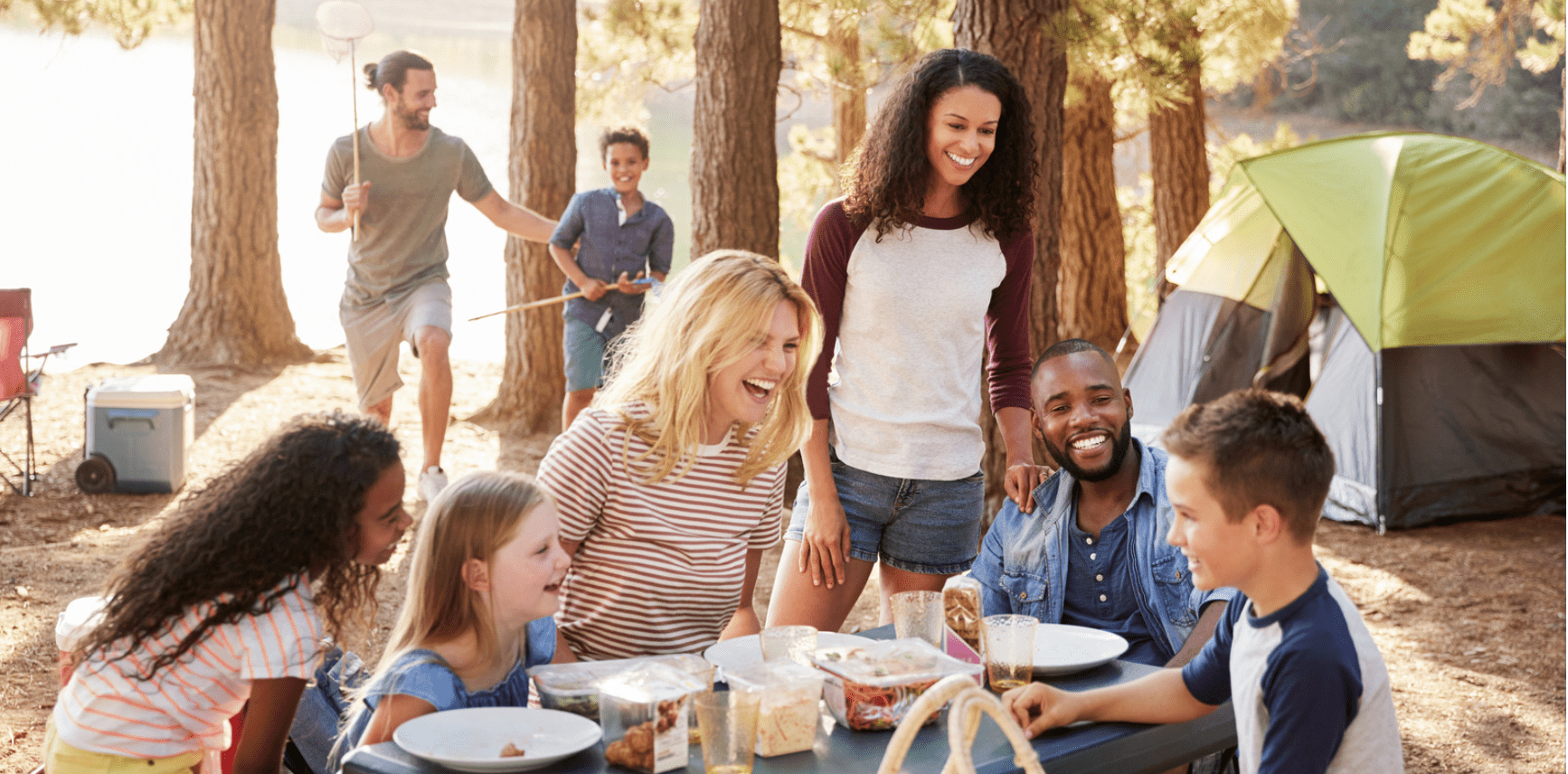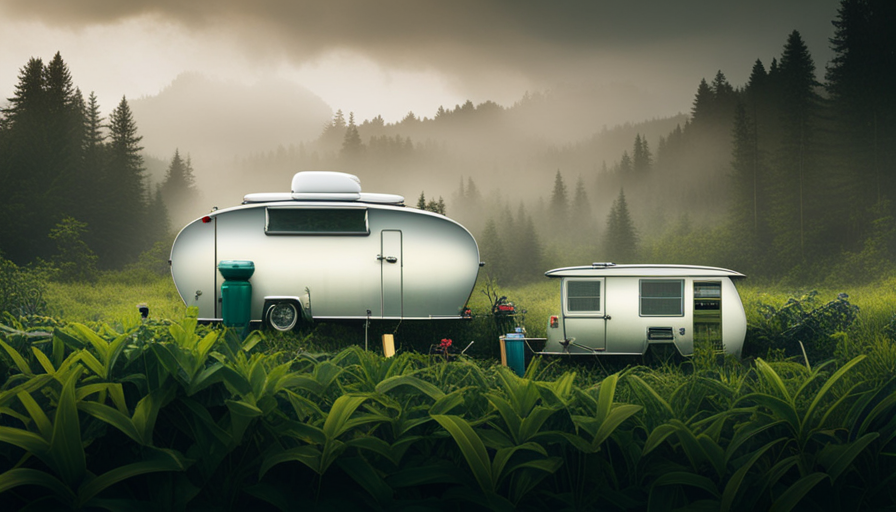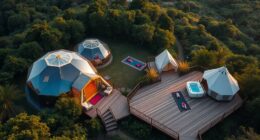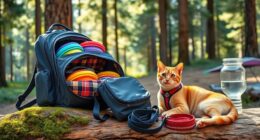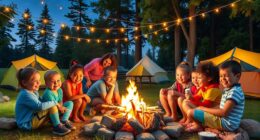Imagine yourself waking up in the peaceful wilderness, surrounded by towering trees and the crisp morning air. As you step out of your cozy camper, ready to begin a day of adventure, pause for a moment. Do you sense it? A chill breeze cutting through you, bringing the fear of a potential disaster: frozen pipes in your camper. This icy worry doesn’t have to ruin your camping trip.
With a few simple steps, you can ensure that your pipes stay warm and flowing, even in the harshest winter conditions. In this article, I will guide you through the process of protecting your camper pipes from freezing. From insulating your pipes to using RV antifreeze, we will cover every practical technique that will keep your water flowing smoothly.
So, grab a cup of hot cocoa, sit back, and let’s dive into the world of preventing frozen camper pipes.
Key Takeaways
- Insulate camper pipes with foam insulation or heat tape to keep them warm and prevent freezing.
- Drain water lines regularly to release pressure and prevent freezing.
- Use a skirt or heat tape on the underbelly of the camper for extra pipe protection.
- Keep cabinets and doors open, use fans, and seal gaps to promote airflow and prevent freezing.
Insulate Your Pipes
To keep your camper pipes from freezing, make sure you insulate them properly. One effective way to do this is by using foam insulation. Foam insulation is a great choice because it’s easy to work with and provides excellent insulation.
Start by measuring the length of the pipes that need to be insulated. Then, cut the foam insulation to fit the measurements. Next, wrap the foam insulation around the pipes, making sure it’s secured tightly. Pay special attention to any areas where the pipes are exposed or vulnerable to the cold. This’ll help to prevent any heat loss and keep the pipes protected from freezing temperatures.
Insulating your pipes is an essential step in keeping your camper warm during the colder months. By properly insulating the pipes, you’re ensuring that the water inside them remains heated and flowing. This is crucial for preventing any potential damage caused by frozen pipes.
In the next section, I’ll discuss additional steps you can take to keep your camper warm and comfortable.
Keep Your Camper Warm
To keep my camper warm during cold weather, I find that using a space heater or electric blanket works wonders. These options provide targeted heat to specific areas, ensuring that I stay cozy and comfortable.
Additionally, I highly recommend using a portable heater with a thermostat, as it allows me to easily control the temperature and maintain a consistent level of warmth throughout the camper.
With these tools, I can confidently tackle chilly nights and enjoy a warm and inviting space.
Use a space heater or electric blanket
Using a space heater or electric blanket can help prevent camper pipes from freezing. When using a space heater, it’s important to prioritize safety. Make sure to keep the heater at least three feet away from any combustible materials and never leave it unattended. Additionally, ensure that the space heater is in good working condition and has proper ventilation.
On the other hand, using an electric blanket is a convenient way to keep warm while also preventing pipes from freezing. Electric blankets provide even heat distribution and can be easily adjusted to your desired temperature. They’re also energy-efficient and cost-effective.
With these options, you can effectively keep your camper warm and protect your pipes from freezing.
Transitioning into the next section, another practical option is to use a portable heater with a thermostat.
Use a portable heater with a thermostat
Imagine the cozy warmth enveloping your camper as you rely on a portable heater with a thermostat to effortlessly maintain a comfortable temperature. Not only does this option provide a practical solution for keeping your camper pipes from freezing, but it also ensures your safety.
Portable heaters with thermostats offer precise temperature control, allowing you to set the desired level and forget about it. This eliminates the need for constant adjustments and reduces the risk of overheating or fire hazards. With a thermostat-controlled heating system, you can rest assured that your camper will stay warm without any guesswork.
Now that we’ve covered the benefits of using a portable heater with a thermostat, let’s move on to the next step: draining the water lines.
Drain Water Lines
Keep your camper pipes from freezing by draining the water lines regularly. This is an essential step to prevent freezing and winterize the pipes in your camper. When the temperature drops, any water remaining in the pipes can freeze and cause them to burst, leading to costly repairs.
To avoid this, start by turning off the water supply to your camper and opening all faucets and valves to release any pressure. Next, locate the low point drains, usually found underneath the camper, and open them to drain out any remaining water. Don’t forget to also drain the hot water tank by opening the drain valve.
Once all the water has been drained, close all the faucets and valves. It’s important to make this a regular habit, especially before temperatures drop below freezing. By regularly draining your camper’s water lines, you can prevent freezing and ensure that your pipes stay intact throughout the winter months.
As we move on to the next section about using a skirt or heat tape on the underbelly, you’ll discover additional ways to keep your camper pipes from freezing.
Use a Skirt or Heat Tape on the Underbelly
To protect your camper’s water lines from freezing, consider using a skirt or heat tape on the underbelly. These insulating options can provide an extra layer of protection against the cold temperatures that can cause pipes to freeze.
A skirt is a fabric barrier that’s attached to the bottom of the camper, creating a seal to prevent cold air from entering and warm air from escaping. It acts as a shield, keeping the underbelly and pipes warmer.
Heat tape, on the other hand, is an electrical heating element that’s wrapped around the pipes. It generates heat to keep the pipes warm and prevent freezing. Both options are effective in maintaining the temperature inside the camper and preventing water lines from freezing.
In addition to using a skirt or heat tape, it’s also important to explore alternative heating methods. This could include using space heaters or portable electric blankets inside the camper to provide extra warmth. These methods can be especially useful during extremely cold weather when the skirt or heat tape may not be sufficient.
As we move on to the next section about disconnecting and storing hoses, it’s crucial to remember that these steps are essential in preventing frozen pipes.
Disconnect and Store Hoses
Don’t forget to disconnect and store your hoses to prevent any potential damage. This is one of the most important preventive measures to take in order to keep your camper pipes from freezing.
By disconnecting and storing your hoses properly, you can avoid any water buildup and ensure that your pipes remain intact during the cold winter months.
To begin, start by turning off the water supply and disconnecting the hoses from the camper. Make sure to drain any remaining water from the hoses before storing them away. This will prevent any water from freezing and causing damage to the hoses or pipes.
Once the hoses are disconnected and drained, it’s important to store them in a dry and insulated area. This will further protect them from freezing temperatures. Consider using a hose bag or a storage container specifically designed for hoses to keep them organized and protected.
In addition to disconnecting and storing your hoses, it’s also a good idea to inspect them regularly for any signs of wear or damage. Replace any hoses that are cracked or leaking to ensure proper functionality.
By following these maintenance tips and taking the necessary precautions, you can keep your camper pipes from freezing and avoid costly repairs.
Now, let’s move on to the next section and discuss how to keep cabinets and doors open to promote air circulation.
Keep Cabinets and Doors Open
To prevent camper pipes from freezing, it’s important to keep cabinets and doors open. This allows warm air to circulate around the pipes and helps to maintain a consistent temperature.
Additionally, using a fan in enclosed spaces can increase airflow and further prevent freezing.
By following these simple steps, you can ensure that your camper pipes stay protected from the cold and avoid any potential damage or inconvenience.
Open cabinets and doors to allow warm air to circulate around pipes
Make sure you open the cabinets and doors in your camper so warm air can circulate around the pipes, preventing them from freezing. Did you know that frozen pipes can burst and cause an average of $5,000 in water damage? By opening the cabinets and doors, you increase ventilation, allowing the warm air to reach all areas and keep the pipes above freezing temperature.
Additionally, make sure to seal any gaps or cracks around the cabinets and doors to prevent cold air from seeping in. This will help maintain a consistent temperature inside the camper and reduce the risk of frozen pipes.
Remember, prevention is key when it comes to frozen pipes, so take the necessary steps to protect your camper.
Now, let’s move on to the next section about using a fan to increase airflow in enclosed spaces.
Use a fan to increase airflow in enclosed spaces
Imagine the refreshing feeling of cool air circulating through your cozy camper thanks to a fan, creating a comfortable and enjoyable atmosphere. When it comes to preventing frozen pipes, increasing ventilation is crucial. Using portable fans can help achieve this goal by enhancing the airflow in enclosed spaces.
Place the fan strategically near the pipes to ensure optimal circulation. Keep in mind that the idea is to promote warm air movement, so avoid pointing the fan directly at the pipes. By increasing airflow, the chances of pipes freezing are significantly reduced.
However, ventilation alone might not be enough to protect your pipes completely. That’s why it’s important to also consider using RV antifreeze as an additional precautionary measure.
Use RV Antifreeze
I always make sure to pour RV antifreeze into the drains and toilet bowls of my camper before winter hits. This helps prevent any water left in the pipes from freezing and potentially causing damage.
Additionally, I add antifreeze to the water tanks and pumping system to ensure they’re protected as well. Taking these simple steps gives me peace of mind knowing that my camper’s plumbing system is safeguarded during the cold winter months.
Pour RV antifreeze into drains and toilet bowls
To prevent frozen pipes in your camper, pour RV antifreeze into the drains and toilet bowls, ensuring the protection of your plumbing system throughout the winter. Here’s how to do it:
-
Start by installing insulation around the pipes to provide extra protection against freezing temperatures.
-
Pour RV antifreeze into each drain, making sure to cover all the pipes. This will prevent any remaining water from freezing and damaging the plumbing system.
-
Don’t forget to winterize your toilets as well. Pour antifreeze into the toilet bowls to prevent any water inside from freezing and causing potential cracks.
By following these steps, you can effectively safeguard your camper’s plumbing system from freezing during the winter months.
Now, let’s move on to the next section about adding antifreeze to the water tanks and pumping system, ensuring comprehensive winterization.
Add antifreeze to water tanks and pumping system
Now that we’ve taken care of pouring RV antifreeze into drains and toilet bowls, let’s move on to another important step in preventing camper pipes from freezing: adding antifreeze to the water tanks and pumping system.
This is an essential measure to protect your camper’s water supply from freezing temperatures. The benefits of using antifreeze in water tanks are twofold. Firstly, it lowers the freezing point of the water, preventing it from turning into ice. Secondly, it helps to displace any remaining water in the system, minimizing the risk of freezing.
However, if you prefer not to use antifreeze in your camper pipes, there are alternatives available. You can insulate the water tanks and pipes with foam or heat tape, or even use portable space heaters in the camper to keep the temperature above freezing.
Before we move on to the next section about monitoring weather conditions, it’s important to ensure that your water tanks and pumping system are properly protected.
Monitor Weather Conditions
Check the forecast regularly to stay informed about the weather conditions and prevent your camper pipes from freezing. Using weather apps can provide you with accurate and up-to-date information about the temperature and any potential cold fronts in your area.
Additionally, installing temperature sensors in your camper can help you monitor the internal temperature and alert you if it drops to a level that may cause the pipes to freeze.
To make sure you’re fully prepared, here are three important things to consider when monitoring weather conditions:
-
Be aware of any sudden drops in temperature, especially during the night, as this is when pipes are most vulnerable to freezing.
-
Pay attention to wind chill factors, as strong winds can make the temperature feel even colder and increase the risk of freezing pipes.
-
Take note of any winter storm warnings or advisories, as these conditions can rapidly escalate and pose a serious threat to your camper’s pipes.
By staying informed and taking necessary precautions based on the weather forecast, you can effectively protect your camper pipes from freezing. However, if you want to further safeguard your pipes, the next step is to install heat pads or heated water hoses.
Install Heat Pads or Heated Water Hoses
I highly recommend attaching heat pads to vulnerable pipes in order to prevent freezing. These heat pads are easy to install and provide a consistent source of warmth to keep your pipes from freezing in cold temperatures.
Additionally, using heated water hoses can ensure a continuous water supply, even in freezing conditions. These hoses are designed to prevent freezing and keep water flowing smoothly, making them a practical and reliable solution for campers.
Attach heat pads to vulnerable pipes
To prevent your camper pipes from freezing, you’ll need to attach heat pads to the vulnerable pipes in order to provide a reliable source of warmth and protect them from the harsh winter temperatures.
Heat pad installation is a straightforward process that can effectively keep your pipes from freezing. Start by selecting heat pads specifically designed for pipe insulation. These pads are equipped with self-regulating technology, ensuring the ideal amount of heat is provided to prevent freezing without overheating.
Clean the pipes thoroughly before attaching the pads, ensuring a secure and tight fit. It’s important to position the heat pads strategically, focusing on the most vulnerable areas where freezing is likely to occur.
By attaching heat pads to your camper pipes, you can ensure a reliable and continuous water supply throughout the winter months.
Use heated water hoses for continuous water supply
To further protect your camper pipes from freezing, another option to consider is using heated water hose alternatives. These hoses are specifically designed to provide a continuous supply of water in cold temperatures without the risk of freezing.
One alternative is an electrically heated water hose, which uses built-in heating elements to keep the water flowing. Another option is a propane-heated water hose, which uses a propane burner to warm the water as it passes through the hose.
The benefits of using heated water hoses are twofold: they prevent freezing and ensure a ready supply of water for all your needs. Whether you choose an electric or propane option, these hoses are a convenient solution for campers who require a continuous water supply in freezing conditions.
Now, let’s move on to the next section and discuss how to regularly check and maintain your camper to prevent freezing issues.
Regularly Check and Maintain Your Camper
Regularly checking and maintaining your camper is essential in preventing frozen pipes. One of the first steps you can take is to ensure that your camper is properly insulated. This will help retain heat and prevent cold air from seeping in. Consider using energy efficient heating options such as portable electric heaters or propane heaters with built-in thermostats. These options can help keep your camper warm without consuming excessive amounts of energy. Additionally, insulating windows and doors is crucial in maintaining a comfortable temperature inside your camper. You can use weatherstripping to seal any gaps and prevent drafts.
To provide a visual representation of the importance of regular maintenance, here is a table showcasing the potential consequences of neglecting your camper:
| Neglected Maintenance | Consequence |
|---|---|
| Not insulating windows and doors | Increased heat loss, higher energy consumption |
| Ignoring leaks or cracks | Water damage, mold growth |
| Failing to clean and maintain heating system | Inefficient heating, potential breakdown |
| Not winterizing plumbing system | Frozen pipes, expensive repairs |
| Neglecting battery maintenance | Power outages, limited electrical supply |
By regularly checking and maintaining your camper, you can prevent these issues and ensure that your pipes remain unfrozen, allowing for a worry-free camping experience even in the coldest weather.
Frequently Asked Questions
How can I prevent my camper pipes from freezing overnight?
To prevent my camper pipes from freezing overnight, I take a few proactive steps. Firstly, I use an anachronistic method by insulating the pipes with heat tape, which adds a touch of sophistication to my approach.
Secondly, I ensure that all the exterior openings are sealed tightly to prevent any cold air from entering.
Additionally, I leave a small stream of water running overnight to keep the pipes from freezing.
These simple yet effective techniques provide overnight camper pipe protection.
Is it necessary to insulate all of my camper pipes, or just the ones exposed to the elements?
It’s necessary to insulate all of my camper pipes, not just the ones exposed to the elements. Insulating all the pipes will ensure that heat is retained and distributed evenly throughout the system, preventing any freezing.
There are various insulating methods you can use, such as using foam pipe insulation or heat tape. These best practices will help maintain the temperature and protect your camper pipes from freezing, even in extremely cold weather.
Are there any specific precautions I should take if I plan on leaving my camper unoccupied for an extended period of time?
When leaving my camper unoccupied for an extended period, I take several precautions to prevent freezing. First, I make sure to drain all the water from the pipes and tanks to avoid any standing water that could freeze.
Secondly, I insulate any exposed pipes with foam pipe insulation to provide extra protection.
Finally, I set the thermostat to a low temperature to keep the interior of the camper from freezing.
These measures ensure that my camper remains safe and protected while I’m away.
Can I use regular household insulation to insulate my camper pipes, or do I need to purchase special insulation designed for RVs?
When it comes to insulating camper pipes, using regular household insulation may not be the most effective solution. RV-specific insulation is designed to withstand the specific temperatures and conditions that campers face, ensuring better protection against freezing. While regular household insulation may be cheaper, it may not provide the same level of insulation and could potentially lead to frozen pipes. Investing in RV-specific insulation is a practical and worthwhile choice to prevent costly damage and ensure the longevity of your camper’s plumbing system.
Is it safe to use heat tape on my camper’s underbelly, or are there any potential hazards I should be aware of?
Using heat tape on your camper’s underbelly can be a safe and effective way to prevent freezing pipes. However, it’s important to follow safety guidelines to avoid any potential hazards.
Make sure to choose heat tape that is specifically designed for RV use and always read the manufacturer’s instructions before installation.
Additionally, if you prefer alternative insulation options, there are products available such as pipe insulation sleeves or foam pipe wrap that can provide effective insulation for your camper pipes.
What Steps Should I Take to Dewinterize My Camper and Prevent Frozen Pipes?
Dewinterizing a camper is crucial to prevent frozen pipes. Start by removing any antifreeze from the plumbing system. Ensure the water heater and water tank valves are closed before connecting the water source. Gradually open each valve and faucet to flush the system. Inspect for leaks, and test all appliances for proper functioning.
Conclusion
In conclusion, it’s crucial to take the necessary precautions to prevent camper pipes from freezing.
By insulating pipes, keeping the camper warm, draining water lines, using a skirt or heat tape on the underbelly, disconnecting and storing hoses, using RV antifreeze, monitoring weather conditions, and installing heat pads or heated water hoses, you can ensure that your camper’s pipes stay safe from freezing.
It’s interesting to note that according to a study conducted by the University of Alaska Fairbanks, freezing pipes can cause an average of $5,000 in damages per incident. Therefore, investing time and effort in preventing frozen pipes is well worth it.
Stay warm and keep your camper safe!

